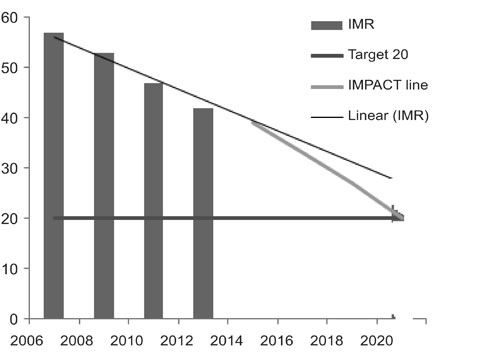|
|
|
Indian Pediatr 2015;52: 193-194 |
 |
Reducing the Infant Mortality Rate of India to
20 by 2020: Together we can do
|
|
S Sachidananda Kamath
National President, Indian Academy of Pediatrics,
2015.
Email: [email protected]
|
|
Over the years, India has attained impressive
achievements in child survival. A fast decline in Infant mortality rate
(IMR) of country has been observed in recent past. The IMR has dropped
by an average rate of 4.56% per year over last five years [1]. However,
at the current pace, the country will miss the target to achieve the
fourth Millennium Development Goal (MDG-4), which aims to reduce
under-five mortality rate and IMR by two-thirds between 1990 and 2015.
Currently, almost all countries of the South East Asia Region have lower
IMR than that of India [2]. Though sixty years ago, India and China had
almost the same IMR, the current IMR in China is just one-fourth of
India’s IMR. China has reduced its IMR by 75% as compared to that of
1990, while India could reduce it only by 53% [2]. Within India, there
exists a large variation in the current rates and percentage reduction
in the IMR [1]. In India, the overall decline in child mortality was
largely hindered by subdued progress in the area of neonatal deaths,
especially within the first week of birth. Averting neonatal deaths is
pivotal in reducing child mortality. Three major causes contribute to
about 75 per cent of all deaths in the new born period: prematurity,
birth asphyxia and infections [3].
Using Auto Regressive Intensive Moving Average
technique, UNICEF estimated the IMR of India at 2020 as 35/1000 live
births (Fig. 1) [4]. Accelerating reduction in infant
mortality calls for new approaches that goes beyond disease-, program-,
and sector-specific approaches. We require a comprehensive approach,
including increasing the coverage of key child survival interventions.
Targeted interventions focussing on poorly performing areas and
increased investment in maternal and child health is needed.
Strengthening of Primary health care in real sense, based on the
principles of equitable distribution, inter-sectoral coordination,
community participation and appropriate technology, will be the
cornerstone of interventions. Commitment to improve the health and
wellbeing of every infant is important, and it needs collective action.
 |
|
Fig. 1 Accelerating the progress of
reduction in IMR of India by Mission 20/20 initiative
|
Infant mortality is the result of a complex web of
determinants at different levels. There are about 23 child survival
interventions with sufficient evidence to reduce under-five mortality,
as described in Lancet Child survival series II [5]. These include
exclusive breast feeding, complementary feeding, safe water,
Hemophilus influenzae b vaccine, zinc, vitamin A, antenatal steroids
for preterm labour, newborn temperature management, tetanus toxoid,
nevirapine for HIV-infected, antibiotics for premature rupture of
membrane, clean delivery, measles vaccine, oral rehydration therapy,
antibiotics for pneumonia, sepsis and dysentery, and newborn
resuscitation. Lancet neonatal survival series has shown that scaling up
of peri-conceptional folic acid supplementation to reduce the incidence
of neural tube defects, calcium supplementation to reduce eclampsia,
detection and treatment of asymptomatic bacteriuria, community-based
pneumonia management, and extra care for low birth weight infants,
including Kangaroo mother care will lead to reduction in neonatal
mortality [6].
Indian Academy of Pediatrics (IAP) has joined hands
with Government in many initiatives, and has been involved in critical
appraisal of Child health programs initiated by Central and State
Governments. IAP has proposed mission 20/20 to accelerate the reduction
in IMR with a target to achieve an IMR of 20 by the year 2020. By
initiating Mission 20/20, the IAP has expressed its willingness to
dedicate its efforts and resources to catalyze the reduction of IMR in
the country. We believe that this initiative will boost the energy and
enthusiasm of all stakeholders to accomplish the noble mission of
attaining the target IMR of 20 by 2020.
I know it is difficult to achieve this mission, but I
am sure that it is possible. Let us join our hands for this noble
mission to make sure that many more children to be born in our country
celebrate their first birthday.
References
1. Estimates of Birth Rate, Death Rate, Natural
Growth Rate, Infant Mortality Rate and Total Fertility Rate by
Residence, 1972-2013. SRS, Registrar General, Vol.48 No.2 September,
2013, India & SRS-2012 (Sept., 13). Available from:
http://planningcommission.nic.in/data/datatable/1203/table_182.pdf.
Accessed February 17, 2015.
2. UN Inter-agency Group for Child Mortality
Estimation (UNICEF, WHO, World Bank, UN DESA Population Division).
Levels and trends in child mortality. Available from:
www.childmortality.org. Accessed February 13, 2015.
3. Lahariya C, Sudfeld CR, Lahariya D, Tomar SS.
Causes of child deaths in India, 1985-2008: A systematic review of
literature. Indian J Pediatr. 2010;77:1303-11.
4. NIMS, ICMR and UNICEF, 2012. Infant and Child
Mortality in India: Levels, Trends and Determinants. New Delhi.
Available from: http://www.unicef.org/india/Report.pdf. Accessed
February 17, 2015.
5. Jones G, Steketee RW, Black RE, Bhutta ZA, Morris
SS; Bellagio Child Survival Study Group. How many child deaths can we
prevent this year? Lancet. 2003;362:65-71.
6. Darmstadt GL, Bhutta ZA, Cousens S, Adam T, Walker
N, de Bernis L; Lancet Neonatal Survival Steering Team. Evidence-based,
cost-effective interventions: How many newborn babies can we save?
Lancet. 2005;365:977-88.
|
|
|
 |
|

